Home >Java >javaTutorial >What is the Java software development life cycle?
What is the Java software development life cycle?
- WBOYWBOYWBOYWBOYWBOYWBOYWBOYWBOYWBOYWBOYWBOYWBOYWBforward
- 2023-04-25 19:40:141783browse
Waterfall Model
The waterfall model is also called the life cycle method. It is the most commonly used development model in the life cycle method. It divides the software development process into software planning, requirements analysis, software design, and program coding. The six stages of software testing, operation and maintenance stipulate their top-down, interconnected fixed order, like a waterfall, falling step by step.
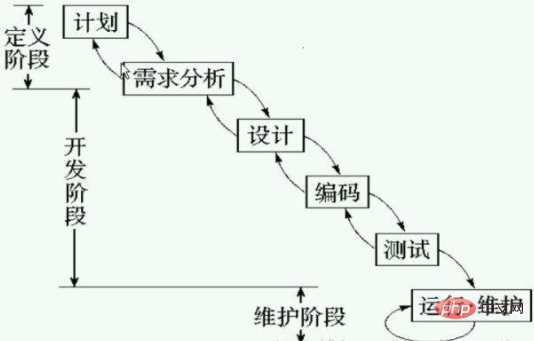
Software plan: mainly determines the development goals and feasibility of the software.
Requirements analysis: After determining that software development is feasible, conduct a detailed analysis of each function that the software needs to implement. The requirements analysis stage is a very important stage. If this stage is done well, it will lay a good foundation for the success of the entire software development project.
Software design: Design the entire software system mainly based on the results of demand analysis, such as system framework design, database design, etc. Software design is generally divided into overall design (outline design) and detailed design.
Program coding: Convert the results of software design into computer-runnable program code. In program writing, unified and standard writing specifications must be formulated to ensure the readability and maintainability of the program and improve the operating efficiency of the program.
Software testing: After the software design is completed, it must be rigorously tested to discover and correct problems existing in the software during the entire design process. During the testing process, it is necessary to establish a detailed test plan and strictly follow the test plan to reduce the randomness of the test.
Software maintenance: Software maintenance is the longest lasting phase in the software life cycle. After the software is developed and put into use, due to various reasons, the software cannot continue to adapt to the user's requirements. To extend the service life of the software, the software must be maintained.
Transformation model
The transformation model (evolution model) is based on the rapid development of a prototype and based on the feedback and suggestions put forward by users in the process of calling the prototype. , improve the prototype, obtain a new version of the prototype, and repeat this process until it evolves into the final software product.
spiral model
The spiral model combines the waterfall model and the transformation model. It combines the advantages of both and adds risk analysis. It is based on the prototype and rotates from the inside out along the spiral. Each rotation requires planning, risk analysis, implementation engineering, customer evaluation and other activities, and a new version of the prototype is developed. After several spiral upward processes, the final system is obtained.
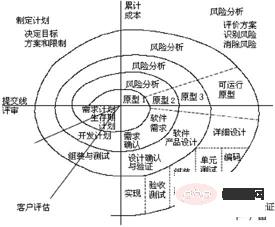
Fountain Model
The fountain model provides support for software reuse and the integration of multiple development activities in the life cycle, mainly supporting object-oriented development methods. The word "fountain" itself embodies the iterative and gapless nature. A certain part of the system is often reworked multiple times, with related functionality added to the evolving system in each iteration. The so-called gapless means that in development activities, there is no obvious boundary between analysis, design and coding.
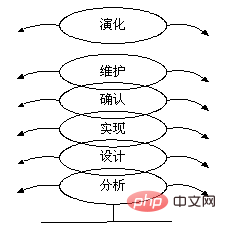
V model
In the development model, testing is often used as an afterthought to make up for the situation, but there are also test-centered development models, then It's the V model. The V model has only received vague recognition in the software industry. The V model claims that testing is not an afterthought, but a process that is as important as the development process.
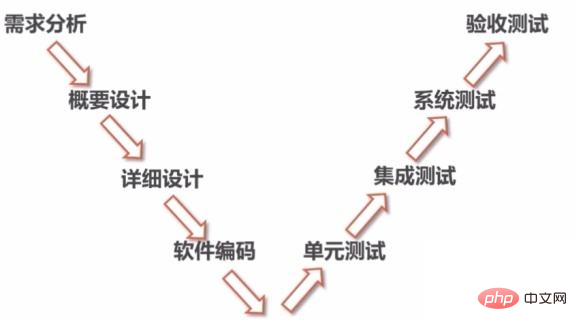
#The V model describes some different test levels and illustrates the different stages in the life cycle that these levels correspond to. In the figure, the descending parts on the left represent the various stages of the development process, and corresponding to this are the ascending parts on the right, which are the various stages of the testing process. Please note that the naming of testing phases may differ in different organizations. The value of the V model is that it very clearly indicates the different levels that exist in the testing process, and clearly describes the correspondence between these testing phases and the stages during the development process:
The main purpose of unit testing is to target various errors that may exist during the coding process. For example: errors in boundary values during user input validation.
The main purpose of integration testing is to target possible problems in the detailed design, especially to check possible errors in the interface between each unit and other program parts.
System testing is mainly aimed at the outline design and checks whether the system as a whole is running effectively. For example: whether the expected high performance is achieved in product settings.
Acceptance testing is usually conducted by business experts or users to confirm that the product can truly meet the user's business needs.
Incremental model
The incremental model, like the prototype implementation model and other evolutionary methods, is iterative in nature. But unlike prototype implementation, the incremental model emphasizes that each increment releases an operational product. Early increments are "detachable" versions of the final product, but they do provide functionality to serve users and provide a platform for user evaluation. The characteristic of the incremental model is that it introduces the concept of incremental packages. There is no need to wait for all requirements to be released. Development can be carried out as long as the incremental package of a certain requirement is released. Although a certain incremental package may need to be further adapted to customer needs and needs to be changed, as long as the incremental package is small enough, its impact on the entire project will be bearable.
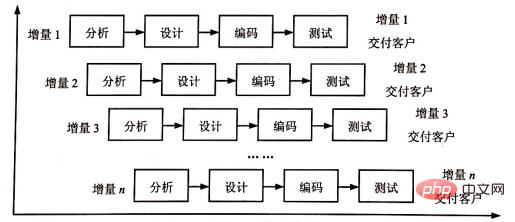
RAD model
Rapid Application Development (RAD) model is an incremental software development process model that emphasizes extreme Short development cycles. The RAD model is a "high-speed" variant of the waterfall model, which uses a component-based construction method to achieve rapid development through the extensive use of reusable components. If the requirements are well understood and the scope of the project is constrained, a fully functional "information system" can be quickly created using this model. The process starts with business modeling, followed by data modeling, process modeling, application generation, testing and iteration. The software process using the RAD model is shown in the figure.
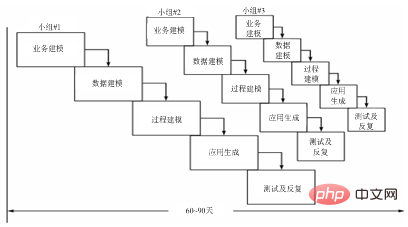
#The tasks to be completed in each activity period of the RAD model are as follows.
Business modeling: What information drives business process operations? What information is to be generated? Who generates it? Where does the information flow go? By whom? This can be supplemented by data flow diagrams.
Data modeling: In order to support the data flow of the business process, find a collection of data objects, define the properties of the data objects, and the relationship with other data objects to form a data model, which can be supplemented by E-R diagrams .
Process modeling: enables data objects to complete various business functions in the information flow. Create a process to describe the addition, modification, deletion, and search of data objects, that is, refine the processing boxes in the data flow diagram.
Application generation: Use the fourth generation language (4GL) to write processing programs, reuse existing components or create new reusable components, and use the tools provided by the environment to automatically generate and construct out of the entire application system.
Testing and delivery, due to a large amount of reuse, generally only overall testing is done, but newly created components still need to be tested.
Component-based model
A component (Component) is a software unit with reusable value and relatively independent functions. The Component Based Software Development (CBSD) model uses modularization methods to modularize the entire system, and with the support of a certain component model, reuses one or more software components in the component library, and through combination The process of constructing application software systems with high efficiency and high quality. The component-based development model incorporates many characteristics of the spiral model, is evolutionary in nature, and the development process is iterative. The component-based development model consists of five stages: software requirement analysis and definition, architecture design, component library establishment, application software construction, testing and release.
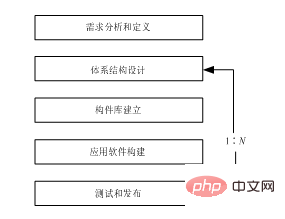
Prototype method
Software prototype is a partial implementation of the proposed new product. The main purpose of establishing the prototype is to solve the problems in product development. For problems with uncertain requirements in the early stages, the purpose is to clarify and refine requirements, explore design options, and develop into the final product. There are many ways to classify prototypes. Depending on whether the prototype implements functions, software prototypes can be divided into two types: horizontal prototypes and vertical prototypes. Horizontal prototypes, also called behavioral prototypes, are used to explore some specific behaviors of the expected system and achieve the purpose of refining requirements. Horizontal prototypes are often just a navigation of functionality without actually implementing it. Horizontal prototypes are mainly used in interfaces. Vertical prototypes, also called structured prototypes, implement part of the functionality. Vertical prototyping is mainly used in complex algorithm implementations.
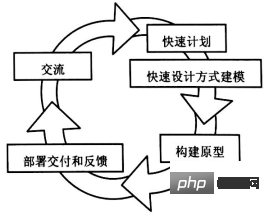
XP method
XP is a lightweight (agile), efficient, low-risk, flexible, predictable, scientific and full of fun software development methods. Compared with other methodologies, its biggest difference is that
provides specific and continuous feedback information earlier and in a shorter cycle.
Plan iteratively, first quickly generating a master plan at the beginning and then evolving it throughout the project development process.
Rely on automated testing programs to monitor development progress and catch defects early.
Relies on verbal communication, testing, and source code for communication.
-
Advocate continuous evolutionary design.
Relies on close collaboration within the development team.
Try to achieve a balance between the short-term interests of programmers and the long-term interests of the project.
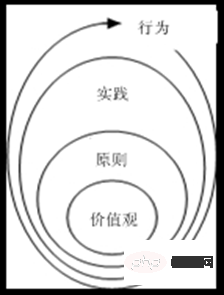
RUP method
RUP (Rational Unified Process) is a unified software development process and a universal process The framework can cope with a wide range of software systems, different application areas, different organizational types, different performance levels and different project sizes. RUP is component-based, which means that the software system developed using it is composed of components, and the components are connected to each other through well-defined interfaces. When preparing all blueprints of the software system, RUP uses the Unified Modeling Language UML. Compared with other software processes, RUP has three significant characteristics: use case-driven, basic architecture-centered, iterative and incremental. The software process in RUP is broken down into four sequential phases in time, namely the initial phase, the refinement phase, the construction phase and the delivery phase. A technical review is scheduled at the end of each phase to determine whether the objectives of the phase have been met. If the review results are satisfactory, the project is allowed to move to the next stage.
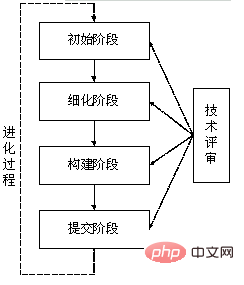
The above is the detailed content of What is the Java software development life cycle?. For more information, please follow other related articles on the PHP Chinese website!
Related articles
See more- How to Inject Dependencies into Self-Instantiated Objects in Spring?
- How to Dynamically Add Files to the Java Classpath at Runtime?
- How to Calculate the Difference Between Two Dates in Days Using Android/Java?
- Why i created a lightweight mini spring alternative and how I did it
- Applying JSON Patch to Entity in a Spring Boot Application: A Practical Guide

